ATSF Tie Treater Site
Site History:
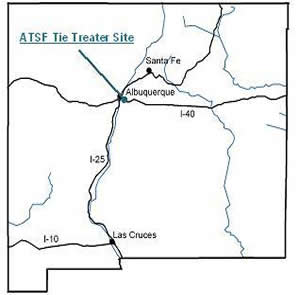
The ATSF Tie Treater Site operated as a wood treating plant from 1908 to 1972. Wood products were treated with creosote, zinc chloride and other agents containing arsenic copper and arsenic.
Location:
The Site is located in Albuquerque, New Mexico approximately one mile from the Rio Grande and the Rio Grande State Park.
Trustees:
State of New Mexico
United States Fish and Wildlife Service
Overview:
The Office of Natural Resources Trustee (ONRT) together with co-Trustee U.S. Department of the Interior Fish and Wildlife Service, entered into a settlement with Burlington Northern Santa Fe Railway for $1,090,000 for injuries to groundwater and wildlife habitat resource caused by releases of hazardous substances at the Atchison Topeka and Santa Fe Tie Treater Site. The January 27, 2005 consent decree designated approximately $396,230 for habitat restoration and approximately $654,962 for groundwater restoration. The remaining amount, approximately $38,807, was for the reimbursement of outstanding damage assessment costs.
Restoration Activities:
A description of groundwater and wildlife restoration projects selected to offset resource injuries are provided in the Groundwater Restoration Plan for the AT&SF Tie-Treater Superfund and the Wildlife Habitat Restoration Plan for the AT&SF Tie-Treater Superfund Site, respectively. Completed restoration projects are listed below starting with the groundwater projects and followed by the wildlife projects.
Isleta Phreatophyte Removal Project
The ONRT funded the removal of 400 acres of exotic, high-water use plants called phreatophytes from the Pueblo of Isleta bosque. The goal of the restoration project was to conserve groundwater through the removal and treatment of phreatophytes such as salt cedar, Russian olive, and Siberian elm. The project also provided additional benefits such as reduction of fire danger, the opportunity for re-settlement and expansion of native vegetation to support wildlife habitat, and improvements to water quality, aesthetics, and recreation. The Pueblo of Isleta implemented the removal of the phreatophytes, and will continue to maintain the suppression of invasive plants into the future. The Mid-Region Council of Governments also provided project oversight assistance. Letter of Appreciation from the Governor of the Pueblo of Isleta ![]()
South Valley Sewer/Water Connection Project
ONRT, in partnership with Bernalillo County, funded the connection of residential houses to municipal sewer and water systems. This project targeted residential owners using septic systems and/or domestic drinking water wells, and who did not qualify for the Bernalillo County Partners in Improvement and Protection of the Environment assistance program. The goals of the South Valley Sewer/Water Connection Project were twofold: (1) protect groundwater from future contamination by decreasing the use of septic systems, and (2) decrease the demand for groundwater by switching from private wells (which use groundwater) to a municipal supply (which uses primarily surface water).
The project successfully funded installation of a sewer trunk line as well as the connection of 11 households to municipal sewer and water systems, and the abandonment of the existing septic tanks.
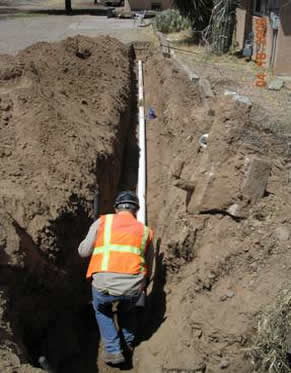
A contractor for Bernalillo County is installing a new PVC sewer line from a private home to the nearest municipal sewer line (4/16/09)
Rio Grande Valley State Park Revegetation Project
The Rio Grande Valley State Park Revegetation Project was completed by ONRT in November 2009 with approximately 200 acres of the Bosque revegetated. The goal of this project was to enhance wildlife habitat in the Bosque with native plantings primarily on land that ONRT had previously cleared of invasive plants.
Plantings included over 7,000 native trees and shrubs, native mix grasses planted on approximately 50 acres of meadows and shallow depression plants on over 25 acres of moist soil areas. In addition, three existing ponds were enhanced and several swales were constructed to support moist soil plants and shrubs, and to attract more wildlife. The vegetation planted included those that re-create a historical Bosque as well as those that will provide food, shelter and nesting opportunities to resident and migratory birds and other wildlife.
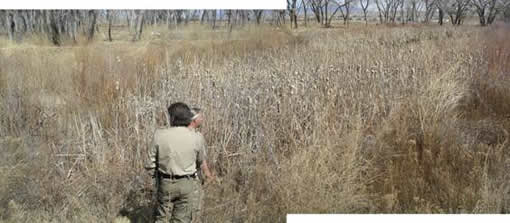
Albuquerque Open Space Division’s Matt Schmader and Martin Martinez near a pond choked with cattails and other unwanted vegetation (3/12/08)
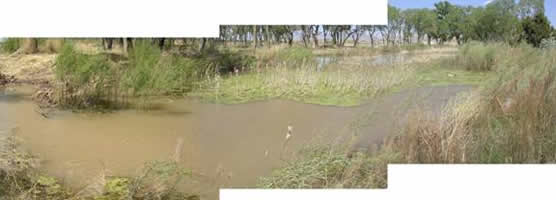
The same pond as above after restoration. Enhancements include removal of unwanted vegetation, planting of native plants, and facilitating the flow of river water into the pond during periods of high flow (5/7/08)
Whitfield Revegetation Project
The Whitfield Revegetation Project included the revegetation of approximately 57 acres in the Whitfield Wildlife Conservation Area. Over 3,680 native trees and shrubs as well as grass and forbs seeds were planted to enhance wildlife habitat.
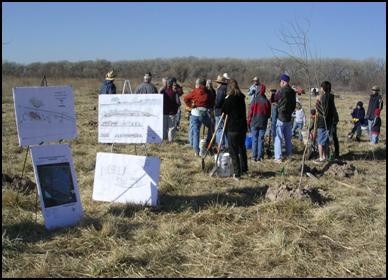
Briefing volunteers before a planting event (3/15/08)

ONRT scientist Will Fetner planting a cottonwood (3/15/08)

